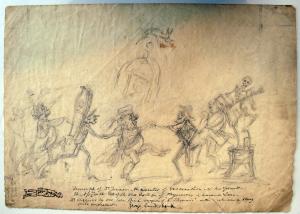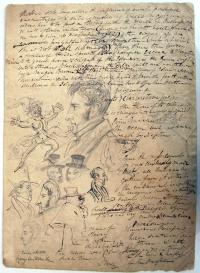George Cruikshank (1792-1878), Triumph of Dr. Jenner …, ca. 1807. Pencil drawing. Inscribed in ink: “Triumph of Dr. Jenner - the inventor of vaccination - & his friends. The [illegible] is on the top of the old College of Physicians on Warwick Lane - [illegible] suggested by old John Birch, surgeon of ‘St. Thomas’s’ and who was a strong anti-vaccinist.”
Early in the nineteenth century, the British public was divided as to the benefits of a small pox vaccine. This sketch by George Cruikshank refers to Edward Jenner (1749-1823) who was a strong advocate for vaccination and John Birch (1745?-1815) who was anti-vaccination. A group of figures with joined hands dance in a circle as a skeleton plays a stringed instrument. One of the figures on the left carries a coffin. On the back of the sheet, Cruikshank wrote some notes around a self-portrait. This drawing has not been matched to any published print.
The vaccination debate led to a number of satirical drawings. James Gillray (1757-1815) published an anti-vaccine print in 1802, depicting cows sprouting and leaping from vaccinated patients. In 1808, the year the government finally established a National Vaccine Institute, Isaac Cruikshank (1756-1811) published an engraving supporting Jenner entitled “Vaccination against Small Pox, or Mercenary & Merciless spreaders of Death and Devastation driven out of Society.”
George Cruikshank illustrated several articles on vaccine quackery in the humorous periodical The Scourge including “The Cow Pox Tragedy” and “The Examination of a Young Surgeon.” See, The Scourge, or, Monthly Expositor of Imposture and Folly (London: W. Jones, 1811-1814). Graphic Arts Collection (GA), Cruik 1811.2


Hmmm...we are still having this discussion even today. Vaccinations have always been perceived by the general public as an odd way to cure disease, and so the conversation continues to this day.